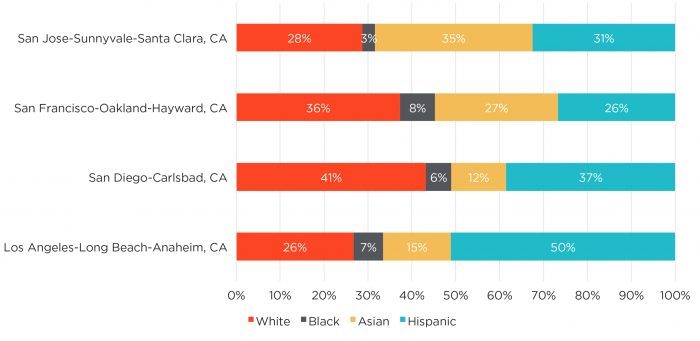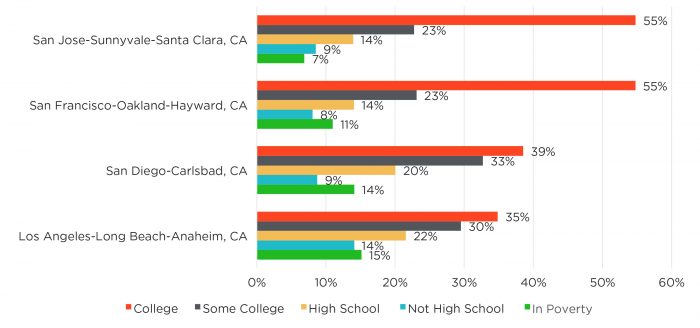California Is Home to the Largest Share of Millennials, and They Are Active Homebuyers
- A recent report by The Brookings Institution took a deep look at the millennial generation (defined as those ages 25 to 34). Millennials are important because they are currently the largest generation since baby boomers. Millennials make up about 25 percent of the U.S. population, 30 percent of the voting population, and 40 percent of the working-age population, and they are increasingly more active homebuyers.
- In addition, millennials are more racially and ethnically diverse than previous generations, as well as more educated. Nevertheless, large differences in educational attainment persist across ethnicities.
- With almost 10 million millennials living in California, the state is home to the largest share of that generation — 13 percent of the population — which other than Texas at 9 percent is double the share of millennials in any other state. In Washington D.C., millennials account for 34.8 percent of the population.
- Los Angeles has the largest millennial population in California and is second to New York nationwide. Figure 1 summarizes population numbers by relevant California metropolitan areas.
- Figure 2 and Figure 3 summarize the racial composition and educational attainment of millennials living in the largest California metro areas. While Bay Area millennials have some of the highest rates of college education, Los Angeles has the largest share of millennials living in poverty. Nationwide, millennials were more likely to be in poverty in 2015 than most baby boomers and Gen Xers were at similar ages.
- A 2016 GenForward survey of millennials found that African Americans and Hispanics consistently report more economic vulnerability than whites or Asians. This has generally stemmed from the loss of wealth resulting from the recent foreclosure crisis, which disproportionately affected African American and Hispanic families, making them less able to provide support for their own and their children’s education and home purchases.
Figure 1: Millennial population size by California metro area

Source: Author’s analysis of U.S. Census Bureau population estimates from William H. Frey, “The Millennial Generation: A Demographic Bridge to America’s Diverse Future” Metropolitan Policy Program, The Brookings Institution, January 2018
Figure 2: Race/ethnic composition of millennials by California metro area

Figure 3: Millennial education attainment and poverty rate in 2015 by California metro area

- Homeownership rates among millennials have lagged when compared with previous generations at the same age. However, millennial homeownership has gained momentum over the last year. According to the most recent U.S. Census Bureau Housing Vacancies and Homeownership survey, the homeownership rate among households headed by a person under the of age 35 increased to 36 percent in the fourth quarter of 2017, up from 34.7 percent year over year. It was the largest homeownership-rate increase of any age group. In contrast, the homeownership rate for Americans between the ages of 45 and 54 declined to 69.5 percent, down from 69.8 percent the previous year.
- According to the U.S. Census Bureau report, states in the West, including California, had the largest increase in overall homeownership rates over the last year, increasing from 59 percent to 60 percent. That 1 percent gain is twice as large as the second-largest increase, which was seen in the South at 0.5 percent.
- Among California metro areas, Los Angeles saw the largest year-over-year increase in the homeownership rate in the fourth quarter, from 48.4 percent to 51.2 percent. On the other hand, the San Francisco metro area saw a 2.9 percent point drop in the homeownership rate, from 57.7 percent to 54.8 percent. The San Jose metro area posted a 0.3 percent increase, bringing the homeownership rate to 50.2 percent.
- While the quarterly U.S. Census Bureau report does not report homeownership rates by age and metro area, transaction data collected by Pacific Union International shows that millennials are the most active homebuyers in San Francisco, where they accounted for 37 percent of transactions over the past six months. Figure 4 summarizes homebuyer age distribution in seven Bay Area regions.
- Bay Area millennials generally purchased homes with median values of $950,000. Half of millennial buyers purchased their homes with 20 percent down payments, while 14 percent bought with all cash. One-quarter of buyers put down more than 20 percent.
Figure 4: Homebuyer distribution by age group in the Bay Area

Source: Pacific Union International. Based on 346 responses collected between Aug. 1, 2017 and Jan. 31, 2018.
Defining Silicon Valley: Pacific Union’s real estate markets in the Silicon Valley region include the cities and towns of Atherton, Los Altos (excluding county area), Los Altos Hills, Menlo Park (excluding east of U.S. 101), Palo Alto, Portola Valley, and Woodside. Sales data in the charts includes all single-family homes in these communities.
Selma Hepp is Pacific Union’s Chief Economist and Vice President of Business Intelligence. Her previous positions include Chief Economist at Trulia, senior economist for the California Association of Realtors, and economist and manager of public policy and homeownership at the National Association of Realtors. She holds a Master of Arts in Economics from the State University of New York (SUNY), Buffalo, and a Ph.D. in Urban and Regional Planning and Design from the University of Maryland.
(Promotional photo: iStock/monkeybusinessimages)
 TEAM WAKELIN
TEAM WAKELIN